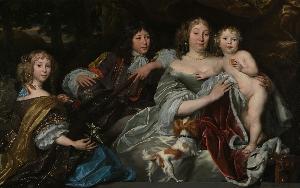Abraham Lambertsz. Van Den Tempel
Abraham Lambertsz. Van Den Tempel;Abraham Van Den Tempel
Place: Leeuwarden
Born: 1622
Death: 1672
Biography:
Abraham van den Tempel, a Dutch Golden Age painter, was born in Leeuwarden, Netherlands, around 1622. He likely received his early artistic training from his father, Lambert Jacobsz, a respected art teacher and Mennonite preacher. Jacobsz had previously instructed notable artists like Govert Flinck and Jacob Adriaensz Backer. After his father's death in 1636, Abraham moved to Amsterdam, where he stayed until 1647, before moving to Leiden.
Training and Career
Abraham became a pupil of Jacob Backer, and studied mathematics at Leiden University. He met with great success with the Leiden city council, earning several generous commissions, including a series of three large allegorical paintings on the cloth industry of Leiden for the Cloth Hall which still hang in their original place today in the Stedelijk Museum De Lakenhal. He became master of the Guild of St. Luke in 1657 and in 1659 he was chartermaster.
Pupils and Legacy
Abraham's pupils included Frans van Mieris the Elder, Carel de Moor, Michiel van Musscher, Ary de Vois, and Isaac Paling. His work can be found in various museums, including the Rijksmuseum in Amsterdam and the Mauritshuis in The Hague. For more information on Abraham van den Tempel's life and work, visit https://Wikioo.org/@/Abraham Lambertsz. Van Den Tempel or https://en.wikipedia.org/wiki/Abraham_Lambertsz_van_den_Tempel. Some of his notable works include:
- The Elder Laughing Boy by Frans Hals The Elder, which can be found at https://Wikioo.org/@@/D3THFP-Frans-Hals-The-Elder-Laughing-Boy
- A Polander Walking Towards the Right by Rembrandt Van Rijn, which can be found at https://Wikioo.org/@@/8EWQS7-Rembrandt-Van-Rijn-A-Polander-Walking-Towards-the-Right
- Our Lord and Disciples at Emmaus by Rembrandt Van Rijn, which can be found at https://Wikioo.org/@@/8EWQWS-Rembrandt-Van-Rijn-Our-Lord-and-Disciples-at-Emmaus
's work is a testament to the Dutch Golden Age art movement, which was characterized by its naturalism, attention to detail, and emphasis on everyday life. His legacy can be seen in the works of subsequent generations of artists, who were inspired by the innovations and achievements of their Dutch predecessors.


